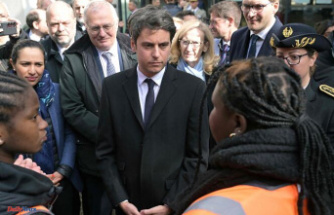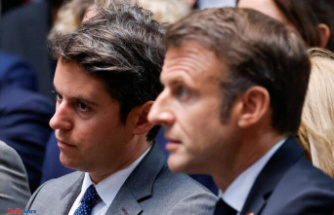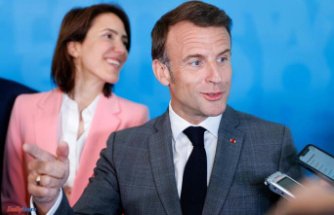Ukraine had only just been able to report successes around Kharkiv and Cherson when Zelenskyj announced the next offensive: Mariupol and Melitopol were also to be liberated. But expert Richter sees major obstacles for the troops.
"All of Ukraine must be free," President Volodymyr Zelenskyy underscored this goal in his video address on Sunday evening. And it gets concrete: The current phase of rest is therefore used to prepare for the next offensive, the aim of which is to recapture Cherson, Mariupol and Melitopol. But does the Ukrainian army still have enough strength to launch another offensive in the near future?
The last figures about losses on the Ukrainian side are from July and come from the official Ukrainian side. They are therefore to be regarded as defensive, since the government will tend to downplay losses with regard to the morale of the troops. The reports at the time lamented 9,000 casualties, but experience has shown that, according to military expert Wolfgang Richter, around three times as many wounded must be added. Taking into account the intense and bloody fighting in May and June as well as the offensive in early September, Richter assumes 12,000 casualties and well over 40,000 total losses.
However, the decisive factor for the offensive power of the troops is above all how many victims there are in the offensive units, which primarily consist of elite forces. In the offensive in Kharkiv, Zelenskyj then praised three brigades involved, two of which were paratrooper units. The approximately 20,000 Ukrainian paratroopers form the core of the offensive troops alongside marines and armored infantrymen.
"Although the paratroopers can only be deployed conventionally, i.e. after a land march, due to a lack of air superiority, they are very combative, well-motivated, well-equipped elite troops," says Richter ntv.de. However, many other elite units are in the Donbass to defend the regions around Luhansk and Donetsk or to take the initiative in the area around Mikolayev. In addition, many other units are tied up to defend a long front of about 1300 km. In this respect, from Richter's point of view, only limited mobile and fire-powered attack units are available for another offensive "in order to expand the operational success in Kharkiv into a strategic turn". Richter has not yet seen this.
Two weeks ago, in interviews with reporters from the Washington Post, those wounded who took part in the Kherson offensive described how high the losses in their units were. The soldiers, housed in a hospital in the hinterland, complained about the technical superiority of the enemy. "If we fired three shells, they would send back 20," one described.
Almost all of the 120 members of the unit were wounded, two dead, according to a summary. Out of 100 men, seven killed, 20 wounded, one other. Even without official figures, one must assume that the elite troops deployed in Cherson and Kharkiv have recorded high losses.
Nonetheless, former Australian Army Major General Mick Ryan sees the momentum continuing to lie with the Ukrainians. A military shock like the one triggered by the successful Ukrainian attack on the Russian troops is "generally a productive time for the offensive," he explains on Twitter. The Russians would have to increase their forces in the east and possibly withdraw troops from the south to do so.
In this phase of shock, Ukraine could make the greatest land gains and achieve the greatest destruction among troops. Ryan sees the offensive so far as proof that the Ukrainian army has the conviction and ability to fight offensively. Ukraine seems to "feel the potential for a major collapse of the Russians in the east."
Richter, on the other hand, is skeptical as to whether the offensive power of the Ukrainian troops and, above all, the logistics behind them are sufficient to launch an in-depth offensive - "especially if the Russians are now sealing off the Ukrainian logistics with rocket and air strikes." The current Russian attacks on Ukraine's energy supply are also aimed "to stop the largely electrified railway that would have to bring supplies and reserves to the front lines."
In order to be able to lead an attack successfully, forces must be concentrated in the spatial focal points. Given the length of the front and limited troop levels, this leads to gaps appearing elsewhere. This creates high risks in thinned out spaces. "The length of the front from Kherson through Melitopol to Mariupol covers the entire southern corridor occupied by Russian troops along the coasts of the Azov and Black Seas, i.e. about 25-30 percent of the entire length of the front. You can't attack simultaneously over such a width," says judge. It is also not possible to split up the troops in such a way that you can attack three cities at the same time with sufficient strength.
In addition, the cities themselves could pose a major obstacle "if the Russians now do what the Ukrainians did before, which was to defend the cities to the last stone". The picture would then be reversed, the Ukrainians would have to attack their own city and use plenty of artillery shelling and firepower to drive out the Russians entrenched there. "In doing so, they would destroy large parts of the cities. Although Mariupol is already a field of rubble, Cherson is largely intact. "Even Melitopol is a city that has so far been almost completely untouched by the war," said Richter. "If you see a city like that attacks, you take a high risk - for your own troops and for the civilian population."
The successful artillery strikes that have already taken place in the area around Cherson in the southwest against targets such as bridges, depots and command posts in the depths could fall on the Ukrainians themselves in a next offensive. The troops had used the German Panzerhaubitze 2000 and the HIMARS rocket launchers from the USA, among other things, to destroy important bridges over the Dnieper from a great distance and cut off the Russian troops from supplies.
But for a deep offensive they would have to cross the river themselves in the opposite direction. "The river would then be a major obstacle for the attacking movements of the Ukrainians. They would have to build pontoon bridges, which in turn would be targets for the enemy to attack," said Richter. Zelenskyi's announcement that he would "lead three major operations against such difficult targets" in the coming offensive could only be "understood as a long-term political project."












